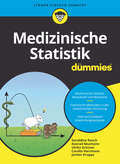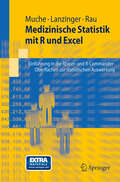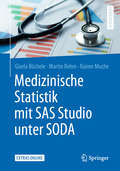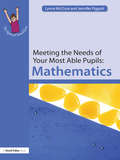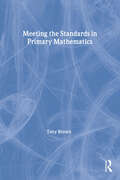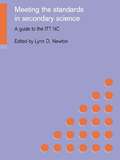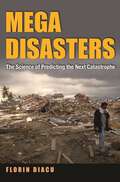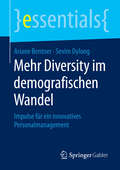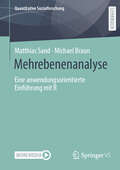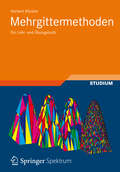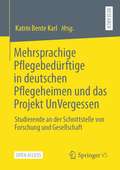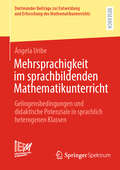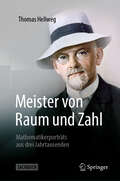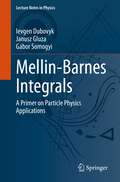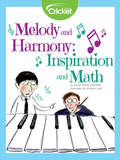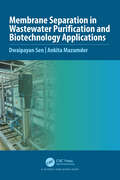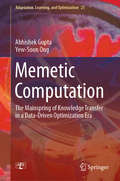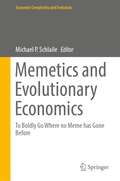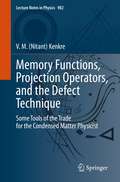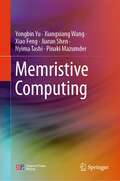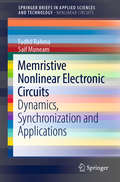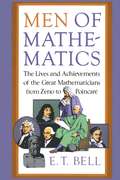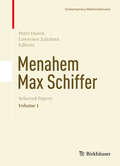- Table View
- List View
Medizinische Statistik für Dummies (Für Dummies)
by Geraldine Rauch Jochen Kruppa Ulrike Grittner Konrad NeumannWenn auch Sie Ihre kleinen Problemchen mit medizinischer Statistik haben, sind Sie hier genau richtig. Mit viel Witz bringen Ihnen die Autoren Geraldine Rauch, Konrad Neumann, Ulrike Grittner, Carolin Herrmann und Jochen Kruppa die Prinzipien der Biostatistik näher. In diesem Buch lernen Sie alles, was Sie benötigen, um Statistik im medizinischen Bereich erfolgreich einzusetzen. Angefangen bei der Begriffskunde und den Grundlagen, erfahren Sie alles von Studientypen über deskriptive Verfahren, Verteilungen, Schätzungen oder Korrelation und Regression bis hin zur Ereigniszeitanalyse, diagnostischen Tests und multiplem Testen. Die Autoren bringen Ihnen das theoretisch vermittelte Wissen mit vielen anschaulichen Beispielen näher. So schaffen Sie die nächste Klausur mit Links!
Medizinische Statistik mit R und Excel
by Rainer Muche Michael Rau Stefanie LanzingerVielfach genutzt für die Verarbeitung von Daten in Tabellenform, war Excel bisher für statistische Analysen weniger geeignet. Seit 2009 kann mit dem Add-In RExcel die Statistiksoftware R eingebunden werden. Der Band bietet die erste Einführung auf Deutsch zur Benutzung der RExcel-Oberfläche. Anhand eines Beispieldatensatzes aus der Herz-Kreislaufforschung werden Deskriptive Statistik, Korrelation und Regression, statistische Tests, Überlebenszeitanalyse sowie Fallzahlplanung nachvollziehbar dargestellt. Mit Schritt-für Schritt-Anleitungen und Tipps.
Medizinische Statistik mit SAS Studio unter SODA
by Rainer Muche Gisela Büchele Martin RehmStatistische Auswertung - selbst gemacht!Der in dem vorliegenden Buch beschriebene Zugang über SAS® OnDemand for Academics (SODA) erlaubt einen kostenfreien, browser-basierten Zugang zur SAS-Software. Dabei können unter SAS Studio in einer menügesteuerten Oberfläche statistische Auswertungen ausgeführt werden. Die Oberfläche ist auch in einer deutschsprachigen Version verfügbar.Das Buch wurde so konzipiert, dass es sich hervorragend zum Selbststudium eignet. Zu Beginn wird eine Einführung in die Benutzung der SAS Studio Oberfläche gegeben. Anhand eines Beispieldatensatzes werden deskriptive Statistik, Korrelation/Regression, statistische Tests, Überlebenszeitanalyse sowie Fallzahlplanung mit zahlreichen Screen-Shots nachvollziehbar dargestellt. Eine Anleitung zur kostenlosen Registrierung von SAS-SODA ist ebenfalls enthalten. Darüber hinaus werden praktische Tipps zur Nutzung und Datenaufbereitung gegeben.So können Sie Ihre statistische Auswertung sicher und schnell selbst erledigen.Die AutorenDr. Gisela Büchele und Martin Rehm sind wissenschaftliche Mitarbeiter am Institut für Epidemiologie und Medizinische Biometrie, Ulm.Prof. Dr. Rainer Muche ist stellvertretender Institutsdirektor des Instituts für Epidemiologie und Medizinische Biometrie, Ulm.
Meeting the Needs of Your Most Able Pupils: Mathematics (The Gifted and Talented Series)
by Lynne McClure Jennifer PiggottMeeting the Needs of Your Most Able Pupils: Mathematics provides specific guidance on: recognising high ability and potential planning, differentiation, extension and enrichment in Mathematicss teacher questioning skills support for more able pupils with special educational needs (dyslexia, ADHD, sensory impairment) homework recording and assessment beyond the classroom: visits, competitions, summer schools, masterclasses, links with universities, businesses and other organisations. The book includes comprehensive appendices with linked resources available online that feature: lesson plans and examples of activities departmental procedures and action plans identification strategies guidance on auditing provision for more able pupils. This book is an essential resource for secondary teachers, subject heads of departments, leading teachers for G&T Education (gifted and talented co-ordinators), SENCos and LA advisers.
Meeting the Standards in Primary Mathematics: A Guide to the ITT NC
by Tony BrownThis book guides readers through the professional standards and requirements to reach Qualified Teacher Status, explaining what trainees need to know. The author discusses the best ways of developing mathematical knowledge and teaching skills, and how to acquire the professional know-how needed to complete the training successfully.will: help readers to understand the Standards related to mathematics teaching offer detailed guidance on the primary mathematics curriculum help readers prepare for the QTS skills test help readers to develop the pedagogical knowledge that you need for effective teaching of mathematics help readers prepare for school-based training provide ideas, suggestions and further reading to support during their training and their NQT year. This practical guide to meeting the standards is invaluable for students on primary training courses, lecturers and mentors supporting trainees in mathematics education programmes and newly qualified teachers.
Meeting the Standards in Secondary Science: A Guide to the ITT NC
by Lynn D. NewtonThis practical, comprehensive and accessible book will prove invaluable for students on secondary initial teacher training courses, PGCE students, lecturers on science education programmes and newly qualified secondary teachers.It provides: the pedagogical knowledge needed to teach science in secondary schools support activities for work in schools and self-study information on professional development for secondary teachers.
Megadisasters: The Science of Predicting the Next Catastrophe
by Florin DiacuThe history and science behind efforts to predict major disasters, from tsunamis to stock market crashesCan we predict cataclysmic disasters such as earthquakes, volcanic eruptions, or stock market crashes? The Indian Ocean tsunami of 2004 claimed more than 200,000 lives. Hurricane Katrina killed over 1,800 people and devastated the city of New Orleans. The recent global financial crisis has cost corporations and ordinary people around the world billions of dollars. Megadisasters is a book that asks why catastrophes such as these catch us by surprise, and reveals the history and groundbreaking science behind efforts to forecast major disasters and minimize their destruction.Each chapter of this exciting and eye-opening book explores a particular type of cataclysmic event and the research surrounding it, including earthquakes, tsunamis, volcanic eruptions, hurricanes, rapid climate change, collisions with asteroids or comets, pandemics, and financial crashes. Florin Diacu tells the harrowing true stories of people impacted by these terrible events, and of the scientists racing against time to predict when the next big disaster will strike. He describes the mathematical models that are so critical to understanding the laws of nature and foretelling potentially lethal phenomena, the history of modeling and its prospects for success in the future, and the enormous challenges to scientific prediction posed by the chaos phenomenon, which is the high instability that underlies many processes around us.Yielding new insights into the perils that can touch every one of us, Megadisasters shows how the science of predicting disasters holds the promise of a safer and brighter tomorrow.
Mehr Diversity im demografischen Wandel: Impulse für ein innovatives Personalmanagement (essentials)
by Ariane Bentner Sevim DylongIn diesem Essential finden Personalverantwortliche und Führungskräfte ausgewählte Hintergrundinformationen zum Thema demografischer Wandel sowie Impulse für ein innovatives und zukunftsfähiges Personalmanagement, das die damit zusammenhängenden Entwicklungen berücksichtigt. Sie erhalten konkrete Hinweise, wie sie ihr HR-Management optimal aufstellen können, um dem demografischen Wandel gewachsen zu sein. Darüber hinaus vermitteln die Autorinnen leicht umsetzbare Strategien für die HR-Praxis und geben Empfehlungen auf der Basis des aktuellen Wissensstandes.
Mehrebenenanalyse: Eine anwendungsorientierte Einführung mit R (Quantitative Sozialforschung)
by Michael Braun Matthias SandDie Mehrebenenanalyse ist ein statistisches Verfahren, das verwendet wird, wenn Daten hierarchisch strukturiert sind, d.h. Einheiten auf dem Individualniveau zu Einheiten aus einem oder mehreren höheren Niveaus gehören (z.B. Schüler in Klassen in Schulen). Es handelt sich um eine spezielle Regressionsanalyse, mit der Abhängigkeiten und Variationen auf verschiedenen Ebenen analysiert werden können. Das Buch behandelt die Logik der Mehrebenenanalyse, ihre wichtigsten statistischen Grundlagen sowie ihre Umsetzung in der Statistikumgebung R. Die Modellierung der Effekte auf verschiedenen Ebenen wird Schritt für Schritt erläutert, wobei ein besonderes Augenmerk auf Modellvergleichen liegt. Zudem werden besondere Anwendungsfälle, etwa kreuz-klassifizierte oder longitudinale Daten, illustriert. Als Beispiel dienen Daten aus der interkulturell vergleichenden Forschung. Datensatz und ergänzende Materialien zu den Kapiteln sind auf der Produktseite des Buches auf SpringerLink verfügbar.
Mehrgittermethoden
by Norbert KöcklerAuf der Grundlage der iterativen Standard-Verfahren zur Lösung von großen, schwach besetzten linearen Gleichungssystemen werden die Mehrgittermethoden an Hand einfacher Modellprobleme eingeführt. Es werden leicht verständlich und mit vielen Beispielen die wichtigsten mathematischen und algorithmischen Eigenschaften behandelt. Übungen mit Lösungen runden den Text ab, der auch als Einführung für Ingenieure geeignet sein soll.
Mehrsprachige Pflegebedürftige in deutschen Pflegeheimen und das Projekt UnVergessen: Studierende an der Schnittstelle von Forschung und Gesellschaft
by Katrin Bente KarlIn diesem Open-Access-Sammelband geht es um das preisgekrönte Projekt UnVergessen, in dessen Verlauf Studierende sprachliche Unterstützung für pflegebedürftige Immigrant*innen in Form von regelmäßigen Besuchen leisten.Deutschland gilt als Einwanderungsland, durch den demographischen Wandel wächst die Anzahl älterer und damit auch pflegebedürftiger Menschen, deren Erstsprache nicht Deutsch ist. Im Alter kann es bei mehrsprachigen Personen zu sprachlichen Ausdrucksschwierigkeiten, v.a. in der später erworbenen Sprache kommen, denen in Pflegeheimen nicht zwangsläufig begegnet werden kann. Eine Folge dessen ist eine zunehmende sprachliche, kulturelle und soziale Isolierung dieser Pflegebedürftigen. Die Beiträge widmen sich dieser Personengruppe und bieten Einblicke in ein besonderes Studienprojekt, das an der Schnittstelle von Forschung und sozialem Engagement für Sichtbarkeit sorgen soll.
Mehrsprachigkeit im sprachbildenden Mathematikunterricht: Gelingensbedingungen und didaktische Potenziale in sprachlich heterogenen Klassen (Dortmunder Beiträge zur Entwicklung und Erforschung des Mathematikunterrichts #53)
by Ángela UribeIn einem verstehensorientierten sprachbildenden Mathematikunterricht wird Sprache als Denkwerkzeug und somit als Schlüssel zum konzeptuellen Verständnis verstanden. Vor diesem Hintergrund stellt sich die Frage nach der Rolle anderer Sprachen neben der Unterrichtssprache im Lehr-Lern-Prozess. Insbesondere in einer mehrsprachigen Gesellschaft – wie Deutschland – treffen im Unterricht diverse Sprachen aufeinander und die Lernenden bringen eine Vielzahl von Ressourcen als Teil ihrer sprachlichen Repertoires mit, die über die Unterrichtssprache hinausgehen. Diese mehrsprachigen Repertoires der Lernenden können gerade für die Bedeutungskonstruktion beim Aufbau von konzeptuellem Verständnis eine wertvolle Ressource darstellen. Das vorliegende Buch trägt dazu bei, den Einbezug dieser vielfältigen Repertoires im Mathematikunterricht in sprachlich heterogenen Regelklassen zu konkretisieren. Es bietet dabei sowohl unmittelbare Ansatzpunkte für die Praxis als auch eine solide Grundlage für zukünftige Untersuchungen, die darauf abzielen, den Mathematikunterricht in einer zunehmend mehrsprachigen Welt weiter zu verstehen und zu verbessern. Das Buch markiert einen bedeutenden Schritt vorwärts im Einbezug von Mehrsprachigkeit als Ressource im Mathematikunterricht und setzt damit ein starkes Signal für eine inklusive und weltoffene Didaktik.
Meister von Raum und Zahl: Mathematikerporträts aus drei Jahrtausenden
by Thomas Hellweg2500 Jahre Ringen um einen scheinbar so einfachen Begriff wie den der Zahl. Eine ebenso lange Beschäftigung mit den Fragen des Raumes, der Messung von Entfernungen und Winkeln, der Geometrie und Astronomie. Schon früh kommt die Erkenntnis, dass sich die räumlichen Verhältnisse mit Zahlen beschreiben lassen und dass hierfür zusätzlich zu den Zählzahlen weitere Zahlen benötigt werden. So wachsen die Konzepte von Raum und Zahl zusammen und unternehmen gemeinsam kaum geahnte Höhenflüge. Die Fragen von Raum und Zahl haben seit dem Altertum begabte Menschen angezogen und beschäftigt, die in einer einmaligen Kontinuität an ihnen gearbeitet haben – die Meister von Raum und Zahl, oder die Mathematiker. Ihre Rolle in der Entwicklung unserer Kultur wird in der Öffentlichkeit kaum wahrgenommen. Dabei gibt es kaum eine faszinierendere Entwicklung in der menschlichen Geistesgeschichte als die der Mathematik.
Mellin-Barnes Integrals: A Primer on Particle Physics Applications (Lecture Notes in Physics #1008)
by Ievgen Dubovyk Janusz Gluza Gábor SomogyiIn this book, the authors discuss the Mellin-Barnes representation of complex multidimensional integrals. Experiments frontiered by the High-Luminosity Large Hadron Collider at CERN and future collider projects demand the development of computational methods to achieve the theoretical precision required by experimental setups. In this regard, performing higher-order calculations in perturbative quantum field theory is of paramount importance. The Mellin-Barnes integrals technique has been successfully applied to the analytic and numerical analysis of integrals connected with virtual and real higher-order perturbative corrections to particle scattering. Easy-to-follow examples with the supplemental online material introduce the reader to the construction and the analytic, approximate, and numeric solution of Mellin-Barnes integrals in Euclidean and Minkowskian kinematic regimes. It also includes an overview of the state-of-the-art software packages for manipulating and evaluating Mellin-Barnes integrals. The book is meant for advanced students and young researchers to master the theoretical background needed to perform perturbative quantum field theory calculations.
Melody and Harmony
by Diana Thistle Tremblay Annette CateDid you know that music is all about math? Every good composer knows their scales, along with the repetition, frequencies, and vibration that go into making harmonies and melodies that are pleasing to hear.
Membrane Biophysics
by Jack A. Tuszynski Mohammad AshrafuzzamanPhysics, mathematics and chemistry all play a vital role in understanding the true nature and functioning of biological membranes, key elements of living processes. Besides simple spectroscopic observations and electrical measurements of membranes we address in this book the phenomena of coexistence and independent existence of different membrane components using various theoretical approaches. This treatment will be helpful for readers who want to understand biological processes by applying both simple observations and fundamental scientific analysis. It provides a deep understanding of the causes and effects of processes inside membranes, and will thus eventually open new doors for high-level pharmaceutical approaches towards fighting membrane- and cell-related diseases.
Membrane Filtration
by Greg FoleyFocusing on the application of membranes in an engineering context, this hands-on computational guide makes previously challenging problems routine. It formulates problems as systems of equations solved with MATLAB, encouraging active learning through worked examples and end-of-chapter problems. The detailed treatments of dead-end filtration include novel approaches to constant rate filtration and filtration with a centrifugal pump. The discussion of crossflow microfiltration includes the use of kinetic and force balance models. Comprehensive coverage of ultrafiltration and diafiltration processes employs both limiting flux and osmotic pressure models. The effect of fluid viscosity on the mass transfer coefficient is explored in detail, the effects of incomplete rejection on the design and analysis of ultrafiltration and diafiltration are analysed, and quantitative treatments of reverse osmosis and nanofiltration process analysis and design are explored. Includes a chapter dedicated to the modelling of membrane fouling.
Membrane Separation in Wastewater Purification and Biotechnology Application
by Dwaipayan Sen Ankita MazumderThe book addresses fundamental principles of the membrane separation technology along with an insight of the modern membrane separation process. Conventional membrane processes are discussed in several books advanced membrane separation processes like ionexchange membrane separation etc. are fragmentally discussed in several scientific journals and patents. Therefore, here the discussion is made on most advanced membrane applications from sensing biomarkers to tissue engineering along with different case studies. It will benefit heterogeneous audience including practitioners, process engineers, researchers and students from chemical engineering, biochemical engineering, and environmental engineering. The most interesting feature that may attract is the inclusion of machine learning in predicting and designing the membrane processes. This book can be referred by someone who wishes to learn about the fundamental principles and a general area of application along with scholars seeking more detailed information about the recent advancement in membrane separation technologies.
Memetic Computation: The Mainspring Of Knowledge Transfer In The Data-driven Optimization Era (Adaptation, Learning, and Optimization #21)
by Abhishek Gupta Yew-Soon OngThis book bridges the widening gap between two crucial constituents of computational intelligence: the rapidly advancing technologies of machine learning in the digital information age, and the relatively slow-moving field of general-purpose search and optimization algorithms. With this in mind, the book serves to offer a data-driven view of optimization, through the framework of memetic computation (MC). The authors provide a summary of the complete timeline of research activities in MC – beginning with the initiation of memes as local search heuristics hybridized with evolutionary algorithms, to their modern interpretation as computationally encoded building blocks of problem-solving knowledge that can be learned from one task and adaptively transmitted to another. In the light of recent research advances, the authors emphasize the further development of MC as a simultaneous problem learning and optimization paradigm with the potential to showcase human-like problem-solving prowess; that is, by equipping optimization engines to acquire increasing levels of intelligence over time through embedded memes learned independently or via interactions. In other words, the adaptive utilization of available knowledge memes makes it possible for optimization engines to tailor custom search behaviors on the fly – thereby paving the way to general-purpose problem-solving ability (or artificial general intelligence). In this regard, the book explores some of the latest concepts from the optimization literature, including, the sequential transfer of knowledge across problems, multitasking, and large-scale (high dimensional) search, systematically discussing associated algorithmic developments that align with the general theme of memetics. The presented ideas are intended to be accessible to a wide audience of scientific researchers, engineers, students, and optimization practitioners who are familiar with the commonly used terminologies of evolutionary computation. A full appreciation of the mathematical formalizations and algorithmic contributions requires an elementary background in probability, statistics, and the concepts of machine learning. A prior knowledge of surrogate-assisted/Bayesian optimization techniques is useful, but not essential.
Memetics and Evolutionary Economics: To Boldly Go Where no Meme has Gone Before (Economic Complexity and Evolution)
by Michael P. SchlaileThis book explores the question of whether and how meme theory or “memetics” can be fruitfully utilized in evolutionary economics and proposes an approach known as “economemetics” which is a combination of meme theory and complexity theory that has the potential to combat the fragmentation of evolutionary economics while re-connecting the field with cultural evolutionary theory. By studying the intersection of cultural and economic evolution, complexity economics, computational economics, and network science, the authors establish a connection between memetics and evolutionary economics at different levels of investigation. The book first demonstrates how a memetic approach to economic evolution can help to reveal links and build bridges between different but complementary concepts in evolutionary economics. Secondly, it shows how organizational memetics can help to capture the complexity of organizational culture using meme mapping. Thirdly, it presents an agent-based simulation model of knowledge diffusion and assimilation in innovation networks from a memetic perspective. The authors then use agent-based modeling and social network analysis to evaluate the diffusion pattern of the Ice Bucket Challenge as an example of a “viral meme.” Lastly, the book discusses the central issues of agency, creativity, and normativity in the context of economemetics and suggests promising avenues for further research.
Memory Functions, Projection Operators, and the Defect Technique: Some Tools of the Trade for the Condensed Matter Physicist (Lecture Notes in Physics #982)
by V. M. KenkreThis book provides a graduate-level introduction to three powerful and closely related techniques in condensed matter physics: memory functions, projection operators, and the defect technique. Memory functions appear in the formalism of the generalized master equations that express the time evolution of probabilities via equations non-local in time, projection operators allow the extraction of parts of quantities, such as the diagonal parts of density matrices in statistical mechanics, and the defect technique allows solution of transport equations in which the translational invariance is broken in small regions, such as when crystals are doped with impurities. These three methods combined form an immensely useful toolkit for investigations in such disparate areas of physics as excitation in molecular crystals, sensitized luminescence, charge transport, non-equilibrium statistical physics, vibrational relaxation, granular materials, NMR, and even theoretical ecology. This book explains the three techniques and their interrelated nature, along with plenty of illustrative examples. Graduate students beginning to embark on a research project in condensed matter physics will find this book to be a most fruitful source of theoretical training.
Memristive Computing
by Pinaki Mazumder Xiao Feng Yongbin Yu Xiangxiang Wang Jiarun Shen Nyima TashiThis book delves into a wide array of topics, ranging from memristor and its emulator to chaotic circuits based on memristor, memristor-based en/decryption systems, filter design based on memristive family, memristive filter for signal processing, memristor network-based swarm intelligence, dynamic analysis of memristive neural networks, and the application of memristor-based neural networks. It provides a comprehensive and systematic exploration of how memristors empower and drive cutting-edge research in neuromorphic computing and artificial intelligence. This book encourages fostering interdisciplinary information literacy and cultivating cross-disciplinary computational thinking. This book plays a pivotal role in embracing and advancing the development of neuromorphic computing. Through profound foundational theories and academic analysis methods, this book guides artificial intelligence graduate students and engineering professionals in constructing a comprehensive knowledge and technological framework for memristor research.
Memristive Nonlinear Electronic Circuits: Dynamics, Synchronization and Applications (SpringerBriefs in Applied Sciences and Technology)
by Fadhil Rahma Saif MuneamMemristive Nonlinear Electronic Circuits deals with nonlinear systems in the design and implementation of circuits for generating complex dynamics. The brief proposes a new memristor model using an inverse tangent function, which achieves the characteristics of the memristor and can be implemented easily because it corresponds to the bipolar transistor differential pair. The authors design a new model-based memristive time-delay system by obtaining a time-delay memristive differential equation, which can generate an n-scroll chaotic attractor by adjusting the proposed nonlinear function. These designs are carried out using OrCAD-PSpice. The brief also presents a new time-delay memristive circuit excited by a nonautonomous staircase function which can generate grid chaotic attractors: new families of grids of n×m-scrolls. For increasingly complex dynamics of the circuits, the authors propose a new five-dimensional autonomous system with two memristors. The dynamical characteristics are investigated by phase portraits and bifurcation diagrams. The brief applies two synchronization methods to the memristive circuits: PC synchronization, and feedback control synchronization. The authors consider synchronization as the idea underlying idea the applications in nonlinear electronic circuits. Finally, the double-memristor system is employed to give rise to a highly secure dual-stage encryption technique.
Men of Mathematics
by E. T. BellHere is the classic, much-read introduction to the craft and history of mathematics by E.T. Bell, a leading figure in mathematics in America for half a century. Men of Mathematics accessibly explains the major mathematics, from the geometry of the Greeks through Newton's calculus and on to the laws of probability, symbolic logic, and the fourth dimension. In addition, the book goes beyond pure mathematics to present a series of engrossing biographies of the great mathematicians -- an extraordinary number of whom lived bizarre or unusual lives. Finally, Men of Mathematics is also a history of ideas, tracing the majestic development of mathematical thought from ancient times to the twentieth century. This enduring work's clear, often humorous way of dealing with complex ideas makes it an ideal book for the non-mathematician.
Menahem Max Schiffer: Selected Papers Volume 1
by Peter Duren Lawrence ZalcmanM. M. Schiffer, the dominant figure in geometric function theory in the second half of the twentieth century, was a mathematician of exceptional breadth, whose work ranged over such areas as univalent functions, conformal mapping, Riemann surfaces, partial differential equations, potential theory, fluid dynamics, and the theory of relativity. He is best remembered for the powerful variational methods he developed and applied to extremal problems in a wide variety of scientific fields.<P><P> Spanning seven decades, the papers collected in these two volumes represent some of Schiffer's most enduring innovations. Expert commentaries provide valuable background and survey subsequent developments. Also included are a complete bibliography and several appreciations of Schiffer's influence by collaborators and other admirers.
